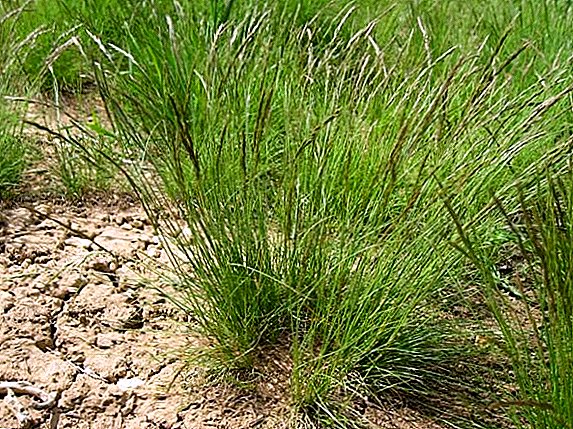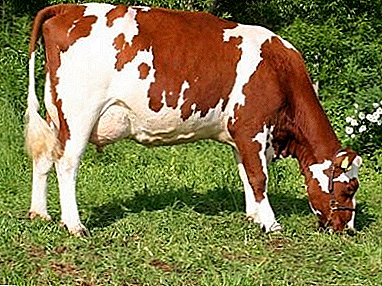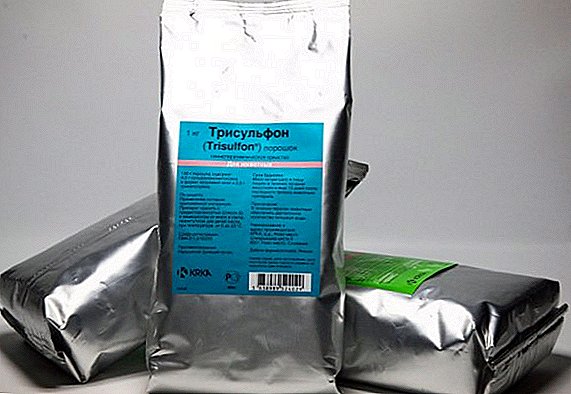 The process of breeding and keeping rabbits is a rather laborious task, which requires a lot of costs and efforts. In order for your pets to stay healthy and active, you need to take care not only of good nutrition and housing, but also remember about the prevention and treatment of diseases. In this article, we consider the therapeutic drug Trisulfon, which is widely used in veterinary medicine for the prevention and treatment of common diseases in animals.
The process of breeding and keeping rabbits is a rather laborious task, which requires a lot of costs and efforts. In order for your pets to stay healthy and active, you need to take care not only of good nutrition and housing, but also remember about the prevention and treatment of diseases. In this article, we consider the therapeutic drug Trisulfon, which is widely used in veterinary medicine for the prevention and treatment of common diseases in animals.
The composition and release form of the drug
Trisulfon is a medicinal drug that provides medical assistance in the fight against bacterial and infectious diseases in poultry, ungulate cubs, pigs and rabbits. This tool belongs to the group of combined chemotherapeutic drugs, which differ in a wide range of effects on pathogens in animals.  The composition of this drug consists of two active ingredients: trimethoprim and sulfamonometoksin in the form of sodium salt. Depending on the form of the drug release, it also contains adjuvants.
The composition of this drug consists of two active ingredients: trimethoprim and sulfamonometoksin in the form of sodium salt. Depending on the form of the drug release, it also contains adjuvants.
Important! Trisulfone used in the treatment and prevention of diseases of the respiratory, digestive and urogenital systems of the animal.This medicine comes in two forms: powder and oral suspension.
Powder
Powder for oral administration has the following characteristics:
- White color;
- easily soluble in water;
- loose;
- no odor.
 One gram of this powder contains 20 mg of trimethoprim and 40 mg of sulfanometoxin. An auxiliary substance in this kind of medicine is lactose monohydrate. The drug in this form is available in hermetically sealed bags weighing 1 kg. The bags are made of foil with a laminated structure, but sometimes a plastic version of the product can be found on the market.
One gram of this powder contains 20 mg of trimethoprim and 40 mg of sulfanometoxin. An auxiliary substance in this kind of medicine is lactose monohydrate. The drug in this form is available in hermetically sealed bags weighing 1 kg. The bags are made of foil with a laminated structure, but sometimes a plastic version of the product can be found on the market.Suspension
The drug in this form is also used for oral administration, is available in bottles of 1 liter. The medicine in the bottle can be whitish or creamy. As in the powder version, the main active substances are also sulfonometoxin and trimethoprim, only the ratio of active ingredients per unit of drug differs.
Did you know? The number of days the rabbit lived in the wild and at home is significantly different. It is known that in the wild the rabbit lives on average a year, while with home care the animal can live up to 12 years.
Thus, it turns out that 100 ml of Trisulfone contains:
- 40 mg sulfamonometoksina;
- 8 g of trimethoprim.
The suspension also contains eight auxiliary substances:
- monocrystalline cellulose;
- polysorbate 80;
- carmellose sodium;
- sorbitol;
- sodium saccharinate;
- benzyl alcohol;
- simethicone;
- demineralized water.
Pharmacological properties
This drug is a combined antibacterial drug with a broad spectrum of lesions of pathogenic bacteria. Trisulfon is effective against most gram-positive and gram-negative microorganisms (Escherichia coli, Salmonella spp., Staphylococcus spp., Streptococcus spp., Shigella spp.), As well as some protozoa - Coccidia and Toxoplasma gondi.
Important! Due to the fact that the active ingredients of the drug block the synthesis and exchange of important amino acids in the cell of a bacteria or protozoa, Trisulfone It is widely used not only in direct treatment, but also in the prevention of disease.
Sulfamonomethoxin interferes with the synthesis of folic acid in the cell of the pathogen. This action is due to the fact that the active ingredient is a competitor to para-aminobenzoic acid, an important chemical compound that is an amino acid. The second active ingredient (trimethoprim) exerts its effect also through the effect on the amino acids of the cell.  Trimethoprim is able to stop the activation of folic acid by blocking dehydrofolate reductase, an enzyme that activates folic acid in the cell itself. The active ingredients are rapidly absorbed into the gastrointestinal tract of the animal, where they have an antibacterial effect within 24 hours after ingestion. The decay products of drugs are excreted by the body mainly by bile and urine.
Trimethoprim is able to stop the activation of folic acid by blocking dehydrofolate reductase, an enzyme that activates folic acid in the cell itself. The active ingredients are rapidly absorbed into the gastrointestinal tract of the animal, where they have an antibacterial effect within 24 hours after ingestion. The decay products of drugs are excreted by the body mainly by bile and urine.
What diseases are used for?
Trisulfone is used to treat the following diseases in rabbits:
- salmonellosis;
- staphylococcus;
- coccidiosis;
- colicbacteriosis;
- pasteurellosis;
- diseases of the digestive system;
- lesions of the respiratory tract;
- pathology of the genitourinary system;
- rhinitis infectious nature.

Dosing and Administration
The method of application is reduced to the oral administration of the drug in the animal, but the dosage for young and adult animals is no different. Trisulfone treatment is carried out either by group or by individual method. Since there are a lot of rabbits in the herd, it is important to start treatment with the drug immediately at the first symptoms of the disease in one individual, and to carry out prophylactic use for the rest of the individuals in the group.
Such an approach is justified by the fact that diseases spread very quickly among rabbits, and a sick animal can cause illness and death of the entire population of rabbits. The dosage of the drug depends on the form of the drug:
- if you use powder, then it is necessary to dissolve 8 g of powder in one liter of water;
- if you are using a suspension, dissolve 1 ml of the substance in 1 liter of water.
 Rabbits need to be fed with this solution during the day, you also need to ensure that animals do not receive other fluids, except water with trisulfone. When using the powder, you can also add medicine to the feed, and the course of antibiotic treatment lasts up to five days. Specify that in coccidiosis the dosage is set in 1 ml of medicine per 1 liter of water, and in other diseases - in 1 ml of Trisulfonan 32 kilograms of body weight of rabbits. The course of treatment can last from three to five days.
Rabbits need to be fed with this solution during the day, you also need to ensure that animals do not receive other fluids, except water with trisulfone. When using the powder, you can also add medicine to the feed, and the course of antibiotic treatment lasts up to five days. Specify that in coccidiosis the dosage is set in 1 ml of medicine per 1 liter of water, and in other diseases - in 1 ml of Trisulfonan 32 kilograms of body weight of rabbits. The course of treatment can last from three to five days.special instructions
After applying the course of treatment with Trisulfone, it is allowed to kill animals no earlier than ten days after the end of the course of treatment. If the rabbits were forced to be killed before this time, their meat can only be used in feeding carnivores, but not included in the human diet.
Did you know? The uterus of the rabbit has a forked anatomical structure. This feature allows the female to bear two broods from different males at once.
Contraindications and side effects
The use of the drug is prohibited for animals in which there are violations in the liver and kidneys. Side effects that would not be caused by individual intolerance to the components of the drug were not identified. 
Shelf life and storage conditions
Storage conditions and shelf life for the drug in the form of a suspension and powder differ:
- for powdered Trisulfone, the shelf life is 4 weeks after opening the medicine bag. In a sealed state, the drug can be stored for up to three years;
- in the form of suspension "Trisulfon" can be used within eight weeks after opening the bottle. In the closed state, the drug can persist for up to three years.
Find out what should be the rabbit keeper in the first aid kit.
To store Trisulfon both in the form of powder and in the form of suspension is necessary at a temperature of from 0 to +25 degrees Celsius. So, bacterial lesions in the rabbit population are a rather serious problem that requires prompt and timely response.
It is worth remembering that negligence in relation to the health of your farm can be fraught with the death of the entire rabbit family. Be attentive to your rabbits and take care of their health in time.












